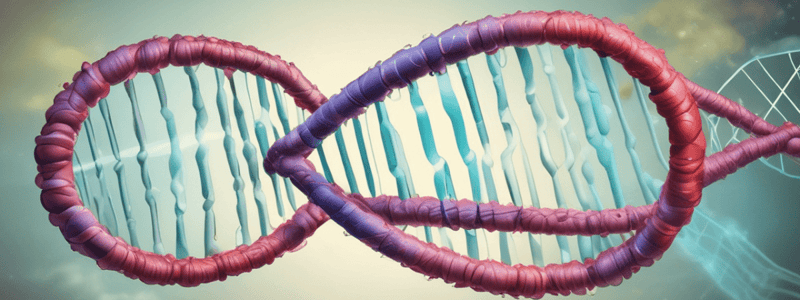Podcast
Questions and Answers
What is the direction of the two polynucleotide chains in the Watson-Crick model of DNA structure?
What is the direction of the two polynucleotide chains in the Watson-Crick model of DNA structure?
- Both chains run in the 3'→5' direction
- One chain runs in the 5'→3' direction, the other in the 3'→5' direction (correct)
- Both chains run in the 5'→3' direction
- One chain runs in the 3'→5' direction, the other in the 5'→3' direction
What is the result of the 3'→5' phosphodiester bond formation between nucleotides?
What is the result of the 3'→5' phosphodiester bond formation between nucleotides?
- A polynucleotide chain with no direction
- A single-stranded nucleic acid chain with no polarity
- A double-stranded nucleic acid chain with polarity
- A single-stranded nucleic acid chain with polarity (correct)
What is the base pairing rule in the Watson-Crick model of DNA structure?
What is the base pairing rule in the Watson-Crick model of DNA structure?
- A pairs with C, and G pairs with T
- A pairs with G, and C pairs with T
- A pairs with T, and C pairs with G by three hydrogen bonds
- A pairs with T, and C pairs with G (correct)
What is the characteristic of the deoxyribose-phosphate backbone in the Watson-Crick model of DNA structure?
What is the characteristic of the deoxyribose-phosphate backbone in the Watson-Crick model of DNA structure?
What is the result of the covalent bonding of phosphate, base, and sugar in nucleotides?
What is the result of the covalent bonding of phosphate, base, and sugar in nucleotides?
Flashcards are hidden until you start studying
Study Notes
DNA Structure and Replication
- A cell's DNA is composed of two sets of chromosomes: a maternal set (n = 3) and a paternal set (n = 3), with a total of 2n = 6 chromosomes.
- Each chromosome consists of two sister chromatids joined at the centromere.
DNA Replication
- DNA replication is a biological process that occurs in all living organisms, copying their DNA, and is the basis for biological inheritance.
- The process starts with one double-stranded DNA molecule producing two identical copies of the molecule.
- DNA replication occurs during the S phase of the cell cycle.
- It is a semiconservative process, resulting in a double-stranded molecule that synthesizes to produce two new double-stranded molecules, each containing one original strand and one new strand.
Origins of Replication
- Replication begins at specific sites on the DNA molecule called origins of replication.
- Origins are specific sequences of bases.
- Mammalian DNA has many origins.
Replication Fork
- The replication fork is a structure that forms within the nucleus during DNA replication.
- It is created by helicases, which break the hydrogen bonds holding the two DNA strands together.
Chargaff Rule
- The Chargaff Rule states that A = T and G = C, which is a base ratio.
Watson-Crick Model of DNA Structure
- The Watson-Crick model describes the structure of DNA as a double helix, where one complete turn is 10 base pairs, and the space between base pairs is 0.34 nm.
- The spatial relationship between the two strands creates a major (wide) groove and a minor (narrow) groove.
- The bases in these grooves are exposed and interact with proteins or other molecules.
- The phosphate backbone has a negative charge, facilitating the binding of specific proteins.
- The model explains how genetic information is stored in the sequence of bases, which have a high coding capacity.
- The model also explains how DNA is copied, and how mutations occur.
DNA Denaturation and Renaturation
- DNA denaturation is the process by which the double strands separate into single strands, disrupting the hydrogen bonds between the paired bases.
- This can be achieved through acidic or alkaline pH, or heating.
- Complementary DNA strands can reform the double helix under appropriate conditions.
Nucleotides Structure
- Nucleotides are formed by covalent bonding of the phosphate, base, and sugar.
- The N-glycosidic bond and phosphate ester bond are key components of nucleotide structure.
Nucleotides Nomenclature
- Deoxyribonucleotides are formed by covalent bonding of the phosphate, base, and sugar.
- Deoxyadenosine (nucleoside) can be phosphorylated to form deoxyadenosine monophosphate (dAMP), diphosphate (dADP), and triphosphate (dATP).
Polynucleotides
- Nucleotides are covalently linked via 3'→5' phosphodiester bonds to form polynucleotides chains.
- The resulting chain has polarity, with a 5'-end and a 3'-end that are not linked to other nucleotides, resulting in a chain with 5'→3' direction.
- DNA has two polynucleotides chains, while RNA has only one.
The Watson-Crick Model of DNA Structure
- According to the Watson-Crick model, DNA is composed of two polynucleotide chains running in opposite directions (antiparallel), one chain running in the 5'→3' direction and the other in the 3'→5' direction.
- The two chains are twisted (coiled) around each other in a right-handed double helix.
- The hydrophilic deoxyribose-phosphate backbone of each chain is on the outside, while the hydrophobic bases are stacked inside, paired by hydrogen bonds.
- The overall structure resembles a twisted ladder.
- Base pairing is highly specific: A pairs with T by two hydrogen bonds, and C pairs with G by three bonds.
Studying That Suits You
Use AI to generate personalized quizzes and flashcards to suit your learning preferences.




